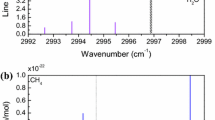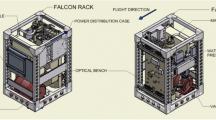Abstract
Commercially available ultraviolet light-emitting diodes (UV-LEDs) are evaluated in the laboratory as a light source for photolysis of atmospheric nitrogen dioxide (NO2) followed by chemiluminescence detection (P-CL) of the resulting nitric oxide (NO). Sensitivity, selectivity, and engineering simplicity of three UV-LED sources are compared. The most powerful source uses two 9-W Nichia LED modules and provides an NO2 photolysis frequency (j) of 8.4 s−1 corresponding to a nine-fold improvement over a 100-W Hg arc lamp; this source provides the most sensitivity, but requires water cooling. A pair of Hamamatsu 0.25-W LED modules provides intermediate sensitivity with photolysis efficiency comparable to a 100-W Hg arc lamp. The Hamamatsu LEDs require no additional cooling and are a simple and inexpensive package, providing sensitivity and stability appropriate for long-term, unattended measurements at remote surface sites. A Droplet Measurement Technologies Blue-Light Converter (BLC) represents the most complete off-the-shelf system available for atmospheric measurements of NO2. The BLC provides the least sensitivity of the LED-based converters, but is less subject to interference from HONO. Implementing the Nichia LEDs into the NOAA WP-3D aircraft P-CL instrument, in conjunction with improved sample gas handling, improves instrument time response by a factor of eight and permits 1-Hz retrieval of ambient NO and NO2 using a single detector simply by modulating the LEDs on and off. The performance and stability of the Nichia LEDs are further assessed during the CalNex (California Research at the Nexus of Air Quality and Climate Change) field study in May and June of 2010.






Similar content being viewed by others
References
Bollinger, M.J.: Chemiluminescent measurements of the oxides of nitrogen in the clean troposphere and atmospheric chemistry implications. doctoral thesis, Univ. of Colo. (1982)
Bradshaw, J., Davis, D., Crawford, J., Chen, G., Shetter, R., Muller, M., Gregory, G., Sachse, G., Blake, D., Heikes, B., Singh, H., Mastromarino, J., Sandholm, S.: Photofragmentation two-photon laser-induced fluorescence detection of NO2 and NO: Comparison of measurements with model results based on airborne observations during PEM-Tropics A. Geophys. Res. Lett. 26(4), 471–474 (1999)
Burkholder, J.B., Ravishankara, A.R., Solomon, S.: UV Visible and IR Absorption Cross-Sections of BrONO2. J. Geophys. Res-Atmos. 100(D8), 16793–16800 (1995)
Clyne, M.A.A., Thrush, B.A., Wayne, R.P.: Kinetics of chemiluminescent reaction between nitric oxide + ozone. Trans. Faraday Soc. 60(4942), 359–370 (1964)
Crowley, J.N., Schuster, G., Pouvesle, N., Parchatka, U., Fischer, H., Bonn, B., Bingemer, H., Lelieveld, J.: Nocturnal nitrogen oxides at a rural mountain-site in south-western Germany. Atmos. Chem. Phys. 10(6), 2795–2812 (2010)
Fontijn, A., Sabadell, A.J., Ronco, R.J.: Homogeneous chemiluminescent measurement of nitric oxide with ozone - implications for continuous selective monitoring of gaseous air pollutants. Anal. Chem. 42(6), 575–579 (1970)
Furlan, A., Haeberli, M.A., Huber, J.R.: The 248 nm photodissociation of ClNO2 studied by photofragment translational energy spectroscopy. J. Phys. Chem. A 104(45), 10392–10397 (2000)
Gao, R.S., Keim, E.R., Woodbridge, E.L., Ciciora, S.J., Proffitt, M.H., Thompson, T.L., Mclaughlin, R.J., Fahey, D.W.: New photolysis system for NO2 measurements in the lower stratosphere. J. Geophys. Res-Atmos. 99(D10), 20673–20681 (1994)
Kley, D., McFarland, M.: Chemiluminescence detector for NO and NO2. Atmos. Technol. 12, 63–69 (1980)
Lee, J.D., Moller, S.J., Read, K.A., Lewis, A.C., Mendes, L., Carpenter, L.J.: Year-round measurements of nitrogen oxides and ozone in the tropical North Atlantic marine boundary layer. J. Geophys. Res-Atmos. 114, (2009). doi:10.1029/2009jd011878
Lenschow, D.H., Raupach, M.R.: The attenuation of fluctuations in scalar concentrations through sampling tubes. J. Geophys. Res-Atmos. 96(D8), 15259–15268 (1991)
Massman, W.J.: The attenuation of concentration fluctuations in turbulent-flow through a tube. J. Geophys. Res-Atmos. 96(D8), 15269–15273 (1991)
Mcfarland, M., Ridley, B.A., Proffitt, M.H., Albritton, D.L., Thompson, T.L., Harrop, W.J., Winkler, R.H., Schmeltekopf, A.L.: Simultaneous insitu measurements of nitrogen-dioxide, nitric-oxide, and ozone between 20 and 31 Km. J. Geophys. Res-Atmos. 91(D5), 5421–5437 (1986)
Merienne, M.F., Jenouvrier, A., Coquart, B.: The NO2 Absorption-Spectrum. 1. Absorption Cross-Sections at Ambient-Temperature in the 300–500 nm Region. J. Atmos. Chem. 20(3), 281–297 (1995)
Parrish, D.D., Hahn, C.H., Fahey, D.W., Williams, E.J., Bollinger, M.J., Hubler, G., Buhr, M.P., Murphy, P.C., Trainer, M., Hsie, E.Y., Liu, S.C., Fehsenfeld, F.C.: Systematic variations in the concentration of NOx (NO plus NO2) at Niwot-Ridge,Colorado. J. Geophys. Res-Atmos. 95(D2), 1817–1836 (1990)
Reidmiller, D.R., Jaffe, D.A., Fischer, E.V., Finley, B.: Nitrogen oxides in the boundary layer and free troposphere at the Mt. Bachelor Observatory. Atmos. Chem. Phys. 10(13), 6043–6062 (2010). doi:10.5194/acp-10-6043-2010
Ridley, B.A., Carroll, M.A., Gregory, G.L., Sachse, G.W.: NO and NO2 in the troposphere - Technique and measurements in regions of a folded tropopause. J. Geophys. Res-Atmos. 93(D12), 15813–15830 (1988)
Ridley, B.A., Walega, J.G., Dye, J.E., Grahek, F.E.: Distributions of NO, NOx, NOy, and O3 to 12-km altitude during the summer monsoon season over New-Mexico. J. Geophys. Res-Atmos. 99(D12), 25519–25534 (1994)
Ridley, B., Walega, J., Montzka, D., Grahek, F., Atlas, E., Flocke, F., Stroud, V., Deary, J., Gallant, A., Boudries, H., Bottenheim, J., Anlauf, K., Worthy, D., Sumner, A.L., Splawn, B., Shepson, P.: Is the Arctic surface layer a source and sink of NOx in winter/spring? J. Atmos. Chem. 36(1), 1–22 (2000)
Ryerson, T.B., Huey, L.G., Knapp, K., Neuman, J.A., Parrish, D.D., Sueper, D.T., Fehsenfeld, F.C.: Design and initial characterization of an inlet for gas-phase NOy measurements from aircraft. J. Geophys. Res-Atmos. 104(D5), 5483–5492 (1999)
Ryerson, T.B., Williams, E.J., Fehsenfeld, F.C.: An efficient photolysis system for fast-response NO2 measurements. J. Geophys. Res-Atmos. 105(D21), 26447–26461 (2000)
Sadanaga, Y., Fukumori, Y., Kobashi, T., Nagata, M., Takenaka, N., Bandow, H.: Development of a Selective Light-Emitting Diode Photolytic NO2 Converter for Continuously Measuring NO2 in the Atmosphere. Anal. Chem. 82(22), 9234–9239 (2010). doi:10.1021/ac101703z
Sander, S.P., Friedl, R.R., Golden, D.M., Kurylo, M.J., Moortgat, G.K., Wine, P.H., Ravishankara, A.R., Kolb, C.E., Molina, M.J., Finlayson-Pitts, B.J., Huie, R.E., Orkin, V.L.: Chemical kinetics and photochemical data for use in atmospheric studies. JPL Publ. 06–2 Jet Propul. Lab., Pasadena, Calif. (2006)
Sather, M.E., Slonecker, E.T., Kronmiller, K.G., Williams, D.D., Daughtrey, H., Mathew, J.: Evaluation of short-term Ogawa passive, photolytic, and federal reference method sampling devices for nitrogen oxides in El Paso and Houston, Texas. J. Environ. Monitor. 8(5), 558–563 (2006). doi:10.1039/B601113f
Stark, H., Lerner, B.M., Schmitt, R., Jakoubek, R., Williams, E.J., Ryerson, T.B., Sueper, D.T., Parrish, D.D., Fehsenfeld, F.C.: Atmospheric in situ measurement of nitrate radical (NO3) and other photolysis rates using spectroradiometry and filter radiometry. J. Geophys. Res-Atmos. 112(D10S04) (2007). doi:10.1029/2006JD007578
Acknowledgments
We thank S. Ciciora for design and construction of a power supply for reliable and fast-response operation of the Nichia LEDs, H. Stark for assistance with UV spectroradiometer measurements, and R. McLaughlin for helpful suggestions regarding the structural design of the new reaction vessel. We also thank the NCAR Community Airborne Research Instrumentation group for the loan of their blue-light converter.
Author information
Authors and Affiliations
Corresponding author
Rights and permissions
About this article
Cite this article
Pollack, I.B., Lerner, B.M. & Ryerson, T.B. Evaluation of ultraviolet light-emitting diodes for detection of atmospheric NO2 by photolysis - chemiluminescence. J Atmos Chem 65, 111–125 (2010). https://doi.org/10.1007/s10874-011-9184-3
Received:
Accepted:
Published:
Issue Date:
DOI: https://doi.org/10.1007/s10874-011-9184-3




